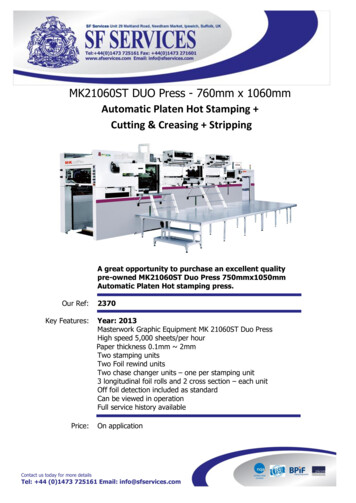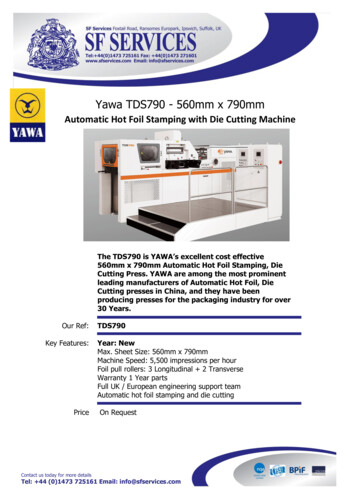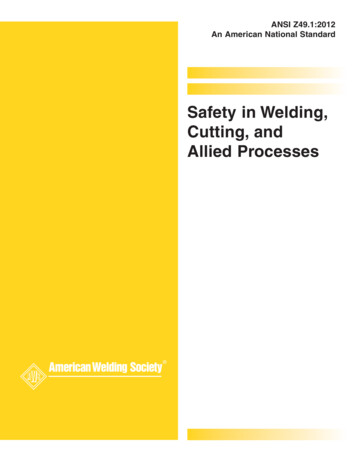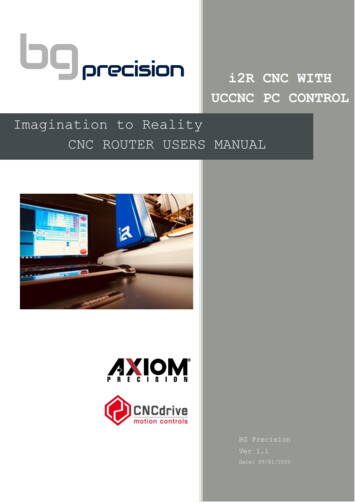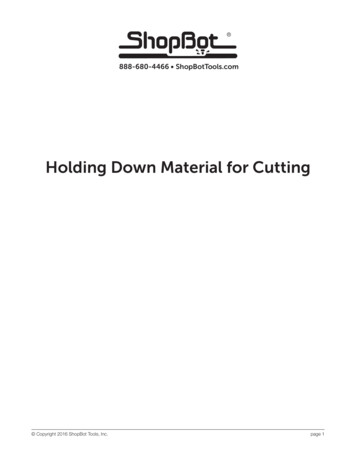
Transcription
888-680-4466 ShopBotTools.comHolding Down Material for Cutting Copyright 2016 ShopBot Tools, Inc.page 1
Holding Down Material for Cutting August 1, 2016 Copyright 2016 ShopBot Tools, Inc.page 2
Holding Down Material for Cutting August 1, 2016Table of ContentsIntroduction.5Screws.5T-Track Tables and Rails.5Clamps.6Press-Fit Jigs.7Adhesives.7Vacuum Hold Down Systems.7Holding Small Parts within the Material.8 Copyright 2016 ShopBot Tools, Inc.page 3
Holding Down Material for Cutting August 1, 2016 Copyright 2016 ShopBot Tools, Inc.page 4
Holding Down Material for Cutting August 1, 2016IntroductionChoosing the right hold down method can be challenging, but it is an important part of project planning. Not only does the work piece need to be held securely, but it is important to know what willhappen to parts as they are cut from the surrounding material. Small parts can be caught by the cutterand thrown across the room, causing serious injury or damage.The following information is a brief overview of different hold down methods.ScrewsIf a spoilboard is set up, screw the workpiece directly to the table. This is a quick and easy methodthat works well for most materials. However, this requires careful planning to make sure that all thescrews are clear of the cut path.With larger jobs it may be necessary to create a hold down toolpath based on the location of othertoolpaths in the file. This will create clearance holes for the screws in safe locations. When using anend mill for drilling, there is very little lateral force on the piece, so less holding power is needed. Oneclamp on each end of the material is enough.Shown here: In SB3 CAD/CAM software, the circle vector tool was used to place several hole locations around the parts. The drilling toolpath is saved as a separate part file so it can be run first. Thematerial is screwed down through these holes, and the main cut file can be run safely.T-Track Tables and RailsThe Shopbot Buddy and Desktop Tools have an aluminum table base that is ideal for setting up moveable clamps and fixtures. On full-size machines, it is possible to set up a system using T-track rails(available from woodworking supply stores), inlaid into the MDF deck. To use this method, ensure therails sit low enough below the surface that they are out of the way when through-cutting. Copyright 2016 ShopBot Tools, Inc.page 5
Holding Down Material for Cutting August 1, 2016ClampsWhether working with a metal T-track table or a spoilboard, there are a variety of clamps that can beused to secure the material. Clamps offer strong holding power and are ideal when there is no excessmaterial to drive screws into. This method, however, requires careful planning to avoid running the toolinto the clamps.In the previous example values were provided to calculate the feed rate.Clamps can also be made from scraps of wood. Here are two examples:A block of wood with a rabbet (groove on one side) can beused on each side. The rabbet height should be slightly lessthan the material height, allowing it to pull down tightly whenscrewed in place.A thin, slightly flexible strip of wood can be used onvarying material thicknesses. Glue a smaller strip acrossit, which will butt against the material to prevent slipping. Copyright 2016 ShopBot Tools, Inc.page 6
Holding Down Material for Cutting August 1, 2016Press-Fit JigsA press-fit jig provides good holding power and canbe made quickly and accurately using the Shopbot.This is a good solution for holding small work pieces,extra-thick stock, or if the material has already beencut to its final size and there is no room for screws.Shown here: two pieces of MDF have been gluedtogether and pocketed out to hold this piece of hardwood. The jig is screwed to the table, then the workpiece is pressed in.AdhesivesAdhesives can be more difficult to work with, but they offer some advantages over other methods.This can work well for thin materials that cannot be held by a press-fit jig. More surface area moreholding power, so small projects will require additional hold-downs.To use tape adhesive, both the table and work piece must be clean, flat, and dust-free. If planning tocut all the way through the material, keep the tape away from the planned toolpath if possible (it maygum up the cutter, reducing cut quality for the rest of the part).For spray adhesive, Super 77 from 3M is highly recommended. Super 77 forms an extremely strongbond within minutes. To avoid damaging the table, bond the workpiece to a scrap board that is cleanand flat, then clamp or screw this board to the table. Some people prefer to glue a layer of paper between the workpiece and support board. This can weaken the bond, but it makes removal easier. Tryboth methods on some scrap to compare.Vacuum Hold Down SystemsA well-sealed vacuum system can be one of the most convenient and effective hold-down methods. Itis ideal for repetitive cutting of plywood and other large sheet materials.Shopbot offers several kits for full-table vacuum systems. It is also possible to build your own. Thereare many resources online for both commercially available and DIY vacuum systems. An internetsearch for “CNC vacuum hold-down” would be a good place to start. Copyright 2016 ShopBot Tools, Inc.page 7
Holding Down Material for Cutting August 1, 2016Holding Small Parts within the MaterialOnce the material is secure, it is still necessary to consider what will happen to parts as they are cut.Large parts may shift as they are cut free, leading to a small gouge or notch along the edge. Smallerparts can be destroyed or thrown by the cutter.There are two ways to handle this from within the software. The first option is to create tabs, or leftover “bridges” of material between the part and its surrounding area. Most CAM programs will have anautomated feature for this. The feature for V-Carve Pro is shown here.Adding tabs in V-Carve ProExample of tabs on a partA second option is to leave an “onion skin,” or very thin layer of material at the bottom of a profilecut. Set the final cut depth at slightly less than the thickness of the material (typically .010” - .030”,depending on material and size). The advantage is that the onion skin provides better hold and can beeasier to trim/sand away than a series of thick tabs. However, if there is a lot of variance in the thickness of the material, or if the table is not flat, then a cut may be too deep or too shallow. Copyright 2016 ShopBot Tools, Inc.page 8
Shopbot offers several kits for full-table vacuum systems. It is also possible to build your own. There are many resources online for both commercially available and DIY vacuum systems. An internet search for “CNC



